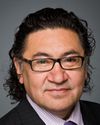Welcome, everybody.
We are here today on the unceded territory of the Algonquin people. We are convening to go clause by clause through Bill S-3.
I'd like to start the business of the meeting by indicating that, pursuant to order of reference of Tuesday, June 13, 2017, the committee begins its consideration of Bill S-3, An Act to amend the Indian Act (elimination of sex-based inequities in registration). We are here today to proceed with consideration of the bill.
We have with us department officials who are here to speak to any technical questions we have or potential impacts the amendments may have. They will not have an opening statement.
I'd like to provide members of the committee with a few comments on how committees proceed with clause-by-clause consideration of a bill. As the name indicates, this is an examination of all the clauses in the order in which they appear in the bill. I will call each clause successively, and each clause is subject to debate and a vote.
If there are amendments to the clause in question, I will recognize the member proposing it, who may explain it. The amendment will then be open for debate. When no further members wish to intervene, the amendment will be voted on. Amendments will be considered in the order in which they appear in the package each member has received from the clerk. If there are amendments that are consequential to each other, they will be voted on together.
In addition to having to be properly drafted in a legal sense, amendments must also be procedurally admissible. The chair may be called upon to rule amendments inadmissible if they go against the principle of the bill or beyond the scope of the bill, both of which were adopted by the House when it agreed to the bill at second reading, or if they offend the financial prerogative of the crown.
If you wish to eliminate a clause of the bill altogether, the proper course is to vote against the clause when it comes time to look at that clause, not to propose an amendment to delete it.
Since this is the first exercise for many new members, the chair will go slowly to allow all members to follow the proceedings properly.
If, during the process, the committee decides not to vote on a clause, that clause can be put aside by the committee so that we revisit it later in the process.
As indicated earlier, the committee will go through the package of amendments in the order in which they appear and vote on them one at a time unless some are consequential and dealt with together.
Amendments have been given a number in the top right corner to indicate which party submitted them. There is no need for a seconder to move an amendment. Once moved, you will need unanimous consent to withdraw it.
During debate on an amendment, members are permitted to move subamendments. I would prefer that you didn't. These subamendments do not require the approval of the mover of the amendment. Only one subamendment may be considered at a time, and that subamendment cannot be amended. When a subamendment is moved to an amendment, it is voted on first. Then another subamendment may be moved, or the committee may consider the main amendment and vote on it.
Once every clause has been voted on, the committee will vote on the title and the bill itself, and an order to reprint the bill will be required, so that the House has a proper copy for use at report stage.
Finally, the committee will have to order the chair to report the bill to the House. That report contains only the text of any adopted amendments, as well as any indication of any deleted clauses.
Thank you for your attention, everyone.
This is a committee that has worked on other very difficult issues, and I'm fairly certain will get through this in an efficient and co-operative manner.
Shall we begin?
(On clause 1)






